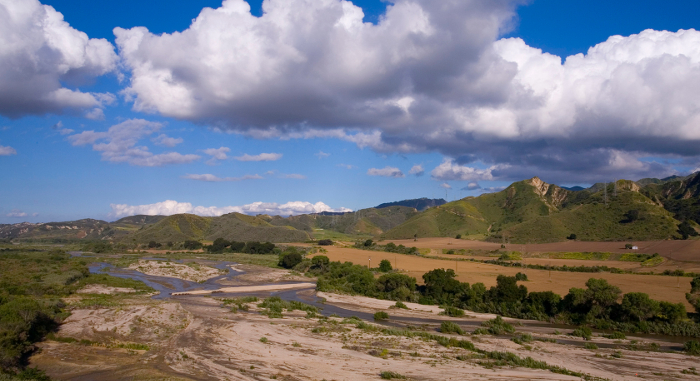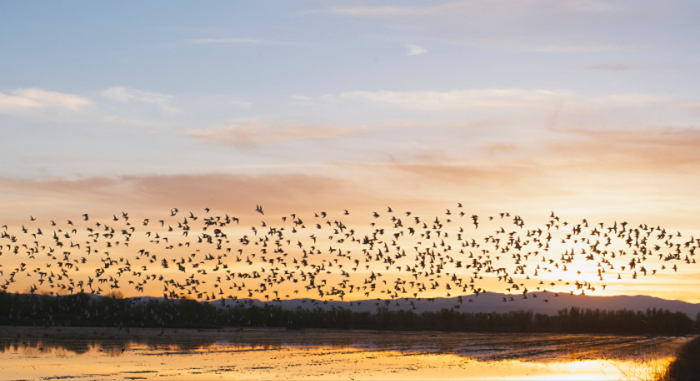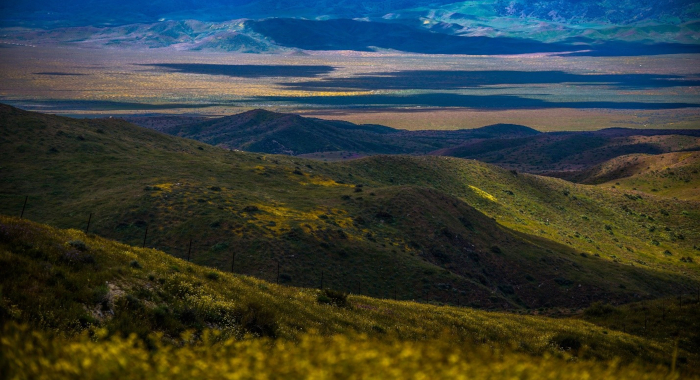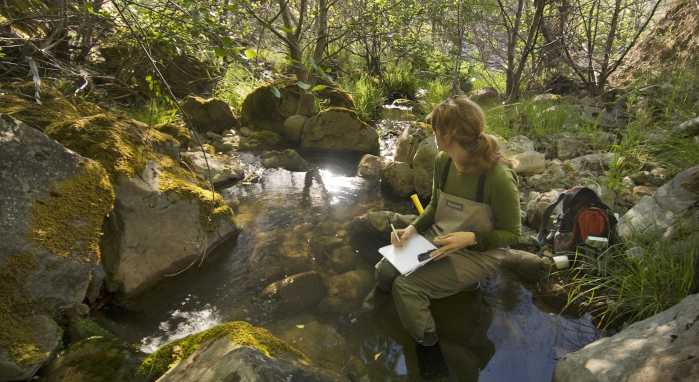California is one of the most hydrologically altered landscapes in the world. As water becomes ever more scarce and the human population continues to grow, that vast engineered system strains to meet the needs of people let alone the needs of nature.
Water rights allocations far exceed actual surface water supply, and millions of wells tap groundwater to meet the increasing demands of farms and communities. As groundwater reservoirs are depleted they can in turn reduce surface flows – exacerbating a vicious cycle in which people and nature both lose. Rivers, wetlands and groundwater-dependent ecosystems are caught in this struggle for an increasingly limited resource. Nearly half of California’s roughly 4,000 freshwater species are considered vulnerable to extinction. Of the taxa that are found nowhere but California – our endemic freshwater biodiversity – 90 percent are at risk.
But there is hope. While it is impossible to return natural flows to most of California’s rivers and streams, we can – through science, technology, and innovative market tools – endeavor to deliver water when and where nature needs it most.




Erin E. Conlisk, Kristin B. Byrd, Elliot Matchett, Austin A. Lorenz, Michael Casazza, Gregory H. Golet, Mark D. Reynolds, Kristin A. Sesser, and Matthew E. Reiter
Landscape-scale wetland conservation requires understanding how wildlife responds to dynamic freshwater habitat availability. This study examined this for dabbling ducks by comparing habitat…The Nature Conservancy, FEMA, Nonlinear Ventures, radbridge, Earth Economics
To address the increasing risk of catastrophic flooding, wildfire and other climate-related threats, communities are pursuing nature-based solutions (NBS) and seeking FEMA hazard mitigation funds to…James W. Roche, Kristen N. Wilson, Qin Ma, Roger C. Bales
This study evaluated the water balance components of precipitation, evapotranspiration, discharge, and change in storage compared to measured streamflow and unregulated streamflow estimates in the…Sophie S. Parker, Linnea S. Hall, Mary J. Whitfield, Laura Riege, Kathryn R. Selm, René Corado
This paper presents results from a field-based study that can be used to benefit songbirds in riverside habitats like those found along the Santa Clara River in Ventura County, California. Songbirds…UC Santa Cruz (Austen E. Stovall, Michael W. Beck), The Nature Conservancy (Alyssa Mann, Tamaki Bieri), Radbridge/formerly Earth Economics (Johnny Mojica, Rowan Schmidt)
Climate change poses severe threats to coastal communities and the ecosystems on which they depend. Warming ocean temperatures increase the magnitude and frequency of storm and coral bleaching events,…Eric D. Stein, Michael E. McClain, Ashmita Sengupta, Theodore E. Grantham, Julie K.H. Zimmerman, Sarah M. Yarnell
In this chapter of Water Resources Allocation and Agriculture, the authors provide insights on how to integrate environmental flows into water allocation for agriculture across the world. They argue…The Nature Conservancy, Earth Economics
FEMA requires that hazard mitigation projects must be cost-effective to the federal government, as demonstrated in a Benefit-Cost Analysis (BCA), which compares the present value of a project’s…Sophie S. Parker, Bradley Franklin, Brian S. Cohen, Melissa M. Rohde, Michael Clifford, Andrew Williams
Climate change will cause severe financial, social, and environmental upheaval if a massive reduction in carbon emissions is not achieved by 2030. To address this challenge, rechargeable lithium-ion…Gregory. H. Golet, Kristen. E. Dybala, Matthew. E. Reiter, Kristin. A. Sesser, Mark Reynolds, Rodd Kelsey
Shorebirds have declined precipitously in North America in the last 50 years, primarily due to the loss of wetlands. Incentive programs that pay farmers to create temporary wetland habitat on idled…Heather Tallis, Joe Fargione, Edward Game, Rob McDonald, Leandro Baumgarten, Nirmal Bhagabati, Rane Cortez, Bronson Griscom, Jonathan Higgins, Christina M. Kennedy, Joe Kiesecker, Timm Kroeger, Trina Leberer, Jennifer McGowan, Lisa Mandle, Yuta J. Masuda, Scott Morrison, Sally Palmer, Rebecca Shirer, Priya Shyamsundar, Nicholas H.Wolff, and Hugh P. Possingham
Spatial analysis is a powerful tool in conservation planning. Yet it is often under-deployed as a means of elucidating which conservation actions may deliver the highest return on investment. This…Christopher J. Lortie, Maria Florencia Miguel, Alessandro Filazzola, Harry Scott Butterfield
Climate change, drought, and water scarcity are driving major land transformations in dryland ecosystems globally. Historically these ecosystems have been disproportionately degraded due to widespread…Carrie Schloss, Liz O’Donoghue, Dan Rademacher, Patric Huber, Jodi McGraw, Kim Becerril, Janine Knapp
Every year, infrastructure agencies and developers spend hundreds of millions of dollars to mitigate for impacts to sensitive species and habitats. These mitigation sites are often piecemeal projects,…Melissa M. Rohde, Tanushree Biswas, Ian W. Housman, Leah S. Campbell, Kirk R. Klausmeyer, Jeanette Howard
Groundwater dependent ecosystems (GDEs) are increasingly threatened worldwide, but the shallow groundwater resources that they are reliant upon are seldom monitored. In this study, the researchers…Melissa M. Rohde, Tanushree Biswas, Ian W. Housman, Leah S. Campbell, Kirk R. Klausmeyer, Jeanette Howard
Groundwater dependent ecosystems (GDEs) are critical habitats throughout California that rely on shallow groundwater. Unfortunately, only a small subset of wells provide monitoring data for shallow…The Nature Conservancy, AECOM
With increase in devasting storms and wildfires due to climate change, we need solutions to help mitigate the impact. Traditionally, “gray” or “hard” infrastructure…Melissa M. Rohde, John C. Stella, Dar A. Roberts, Michael Bliss Singer
This study combines satellite, groundwater, and streamflow data over a 5 year period (2015-2020) to understand the impacts of groundwater depth and streamflow alteration on groundwater-dependent…Roland Geyer, Jenna Gavigan, Alexis M. Jackson, Vienna R. Saccomanno, Sangwon Suh, Mary G. Gleason
Synthetic microfibers are the most prevalent type of microplastic and apparel washing is a major source of microfiber pollution. Using California as a case study to estimate the magnitude of…Gabriel Rossi, Darren Mierau, Jennifer Carah
A simple stream depth measurement at the deepest part of a riffle crest in a river or stream provides an easy-to-measure and inexpensive metric for ecological researech, environmental flow management,…Theodore E. Grantham, Daren M. Carlisle, Jeanette Howard, Belize Lane, Robert Lusardi, Alyssa Obester, Samuel Sandoval-Solis, Bronwen Stanford, Eric D. Stein, Kristine T. Taniguchi-Quan, Sarah M. Yarnell, Julie K. H. Zimmerman
Protecting water in rivers is made more challenging by the lack of quantitative estimates of the amount of water required to protect river ecosystems. The authors developed a model and made…Kate Longley-Wood, Mary Engels , Kevin D. Lafferty, John P. McLaughlin, Alex Wegmann
Native forests on tropical islands have been displaced by non-native species, leading to calls for their transformation. Simultaneously, there is increasing recognition that tropical forests can help…